There’s always something festive and celebratory in the air this time of year – and in the world of Magic, what we’re currently celebrating is Kamigawa. With each new spoiler or info drop, Wizards of the Coast continues to show us what their futuristic, cyberpunk take on the plane will look like, establishing its new identity through some awesome concept artwork.
But Kamigawa: Neon Dynasty is still a return set, no matter how far forward the timeline has skipped. Wizards wouldn’t be bothering to resurrect an almost 20-year-old setting if it didn’t have some amount of recognition and cachet among their players. Despite being sandwiched between the incredibly powerful and prominent debuts of Mirrodin and Ravnica, the original Kamigawa block contributed a swathe of iconic and memorable card designs which have helped define its place in the Magic subculture.
As WotC prepares for a January dedicated to Kamigawa’s lore and history, let’s take our chance to commemorate those cards and the impact they’ve had across all formats of the game.
WHAT MAKES A CARD ICONIC?
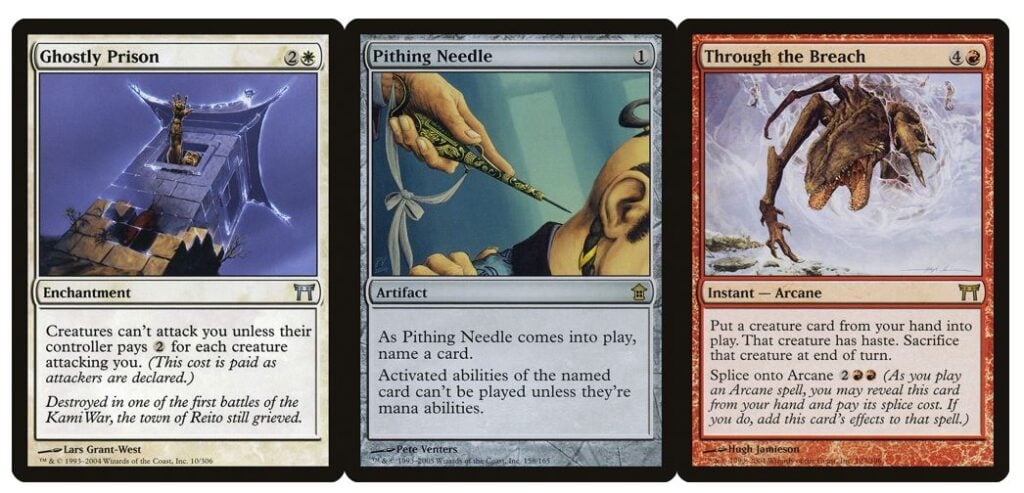
Right away, I should make note of a few cards which have earned Honorable Mentions for this list. Ghostly Prison, Forbidden Orchard, Time Stop, Pithing Needle, and Through The Breach are all noteworthy, memorable cards from the original Kamigawa block.
But the player base doesn’t necessarily remember them as Kamigawa cards! Some, like Prison and Needle, have been reprinted using art and flavor that obscures their connection to the plane. Others have become more strongly associated with their respective Constructed archetypes – most players would likely connect Through the Breach with Emrakul and Zendikar before thinking of Kamigawa, or Glimpse of Nature with Elves. We’re looking for cards which are unmistakably remembered as part of this plane – and luckily, there’s no shortage of those.
20. Ninja of the Deep Hours
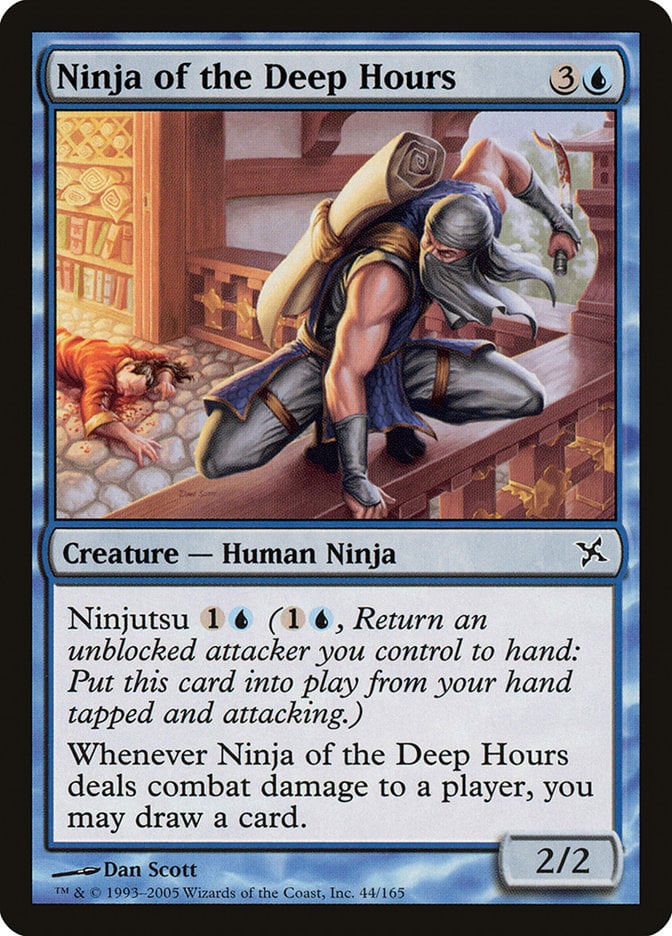
Last week, I predicted the now-confirmed reappearance of ninjutsu in Neon Dynasty. Ninjas were the most successful and well-liked aspect of the original Kamigawa block, and until we started adding more Ninjas through supplemental sets, Ninja of the Deep Hours was the one most responsible for flying that hard-to-detect flag – playing significant roles in Pauper and Cube as well as Commander.
19. Enduring Ideal
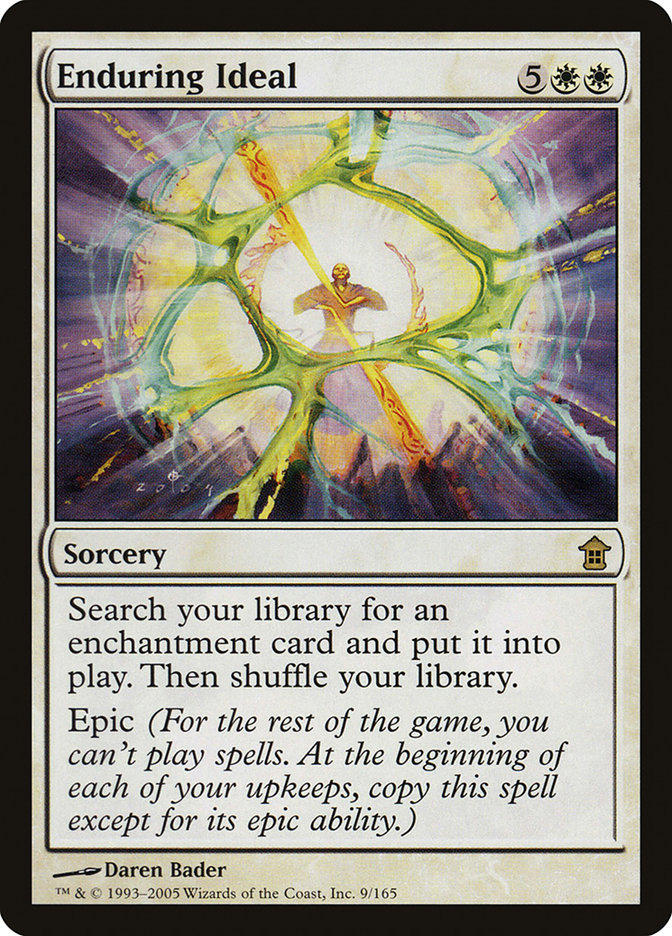
The epic mechanic is far less likely to make a comeback in our second visit to Kamigawa, but that doesn’t mean we should discount this first showstopping cycle of sorceries. While all five are by nature designed to be build-arounds, Eternal Dominion and especially Enduring Ideal really took off and became lingering archetypes in Constructed. A rare option to play a big-mana deck in white, Modern Enduring Ideal is the kind of quirky rogue list that reminds us how open and expressive Magic can be!
18. Honden of Night’s Reach (and the whole Honden cycle)
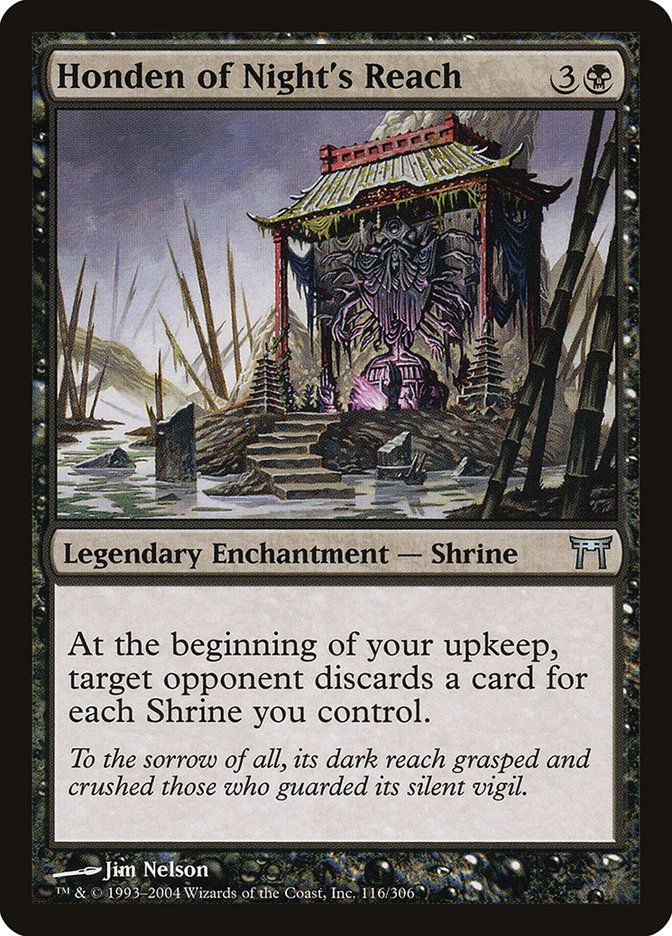
Competitive viability is one way to make a card stand out in Magic history, but sometimes all it takes is for the game itself to recognize the card’s uniqueness. By adding a new enchantment subtype and having those enchantments scale like a tribal deck, the Champions of Kamigawa team captured the imagination of casual players so thoroughly as to justify the eventual revisiting of Shrines in M21, including the long-awaited five-color “Shrine to Rule Them All.” But crowd-pleasing designs like that are only commonplace in 2021 because of what WotC learned from experiments like the Hondens back in 2004.
17. Kodama of the North Tree
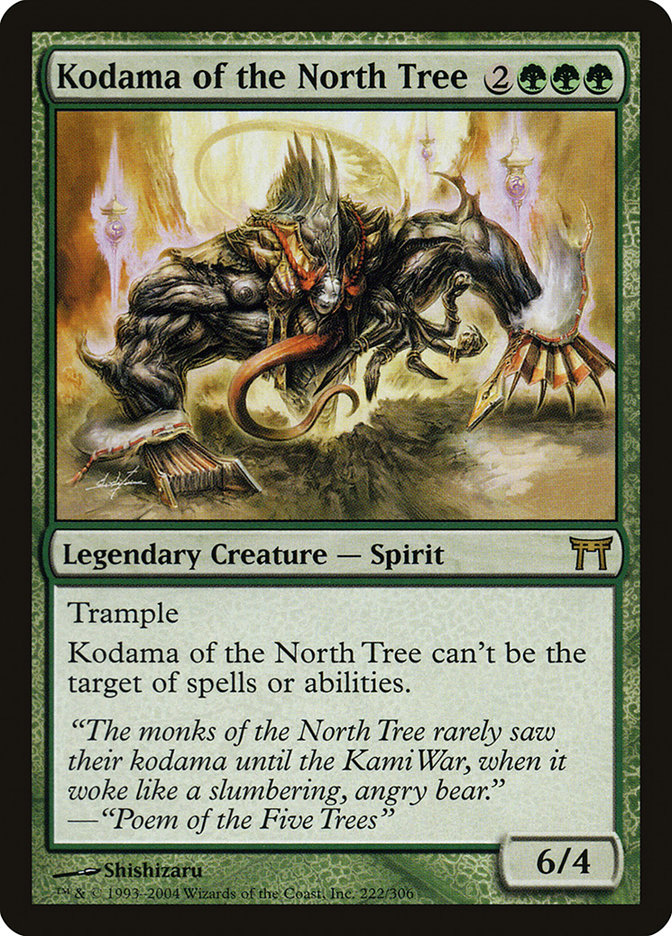
Long before “Carny-T” made its name as Standard’s untargetable boogeyman, it was “Northy Tree” coming out of the sideboard to punish opponents. Bucking the trend of understatted Spirits in Kamigawa block, this beatstick promised six damage a turn for well below the accepted rate of the day. In the process, it became one of those cards that stretches the removal choices of deck builders just by existing ominously at the edge of a format. The venerable Kodama may not look like much today, but it’s a great example of how no Magic card can be evaluated in a vacuum.
16. Heartbeat of Spring

To me, this card epitomizes the potential of “two-sided” design. You can have a mana-doubling enchantment for one mana less than the notorious Wilderness Reclamation, bereft of any further twists or limitations – and simply by granting its power to everyone at the table, the card is both balanced and hugely interesting to plan around. Do you play it on curve and challenge your opponent to do more with the mana than you will? Do you aim to win the turn it comes down to deny them its use, or just sacrifice it before your opponent untaps?
Heartbeat Combo was one of the very first constructed decks to fascinate me and challenge my understanding as a new Magic player, and I hope to one day touch upon that unlikely assemblage of cards in our Combo Crash Course series.
15. Godo, Bandit Warlord

Perhaps the most valid and lasting criticism of Kamigawa block is against its creature selection – a forgettable lineup of french-vanilla Samurai and Spirits. But a few of the legendary ones manage to rise above their humble statlines – in this case, a 3/3 for six! – and take their place in Magic history. Thanks to some badass Paolo Parente artwork and an effect that grows more powerful by the year, Godo immediately established himself as a premiere choice for Commander. That status was cemented with the printing of Helm of the Host back in Dominaria, which gave cEDH players a “no-card infinite” that wins out of the command zone. Turns out all those spears in the background were just an infinite number of identical Godos this whole time!
14. Ebony Owl Netsuke
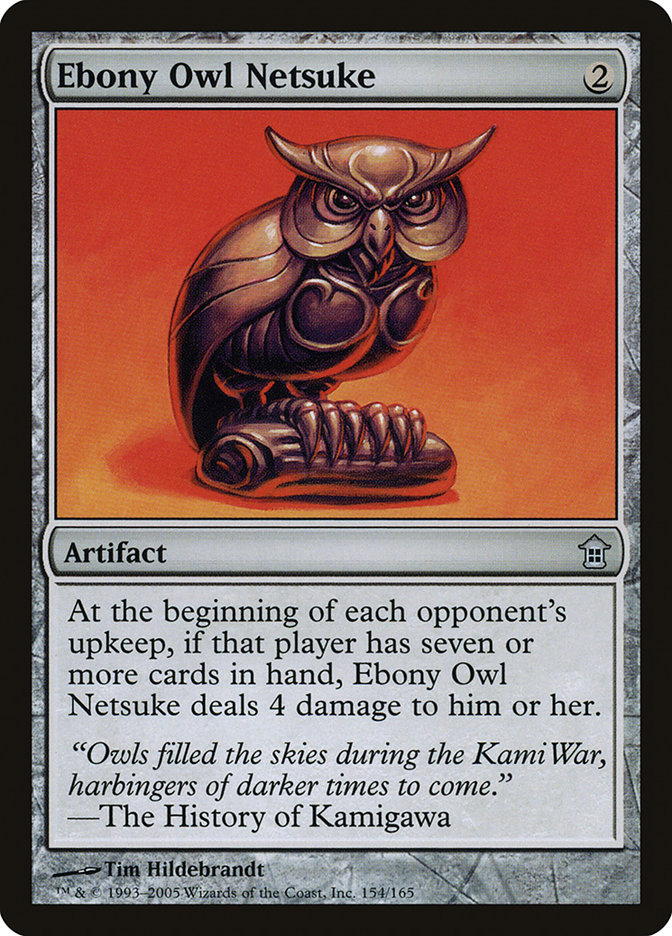
Proving that you can’t underestimate the power of a good pun, Ebony Owl Netsuke slides into our list despite a much more limited window of relevance compared to its neighbors. But in its heyday around 2006, this little artifact combined the novelty and build-around potential of the Hondens with the killing power of a bona fide Pro Tour contender as the centerpiece of blue-red “Owling Mine”!
Killing your opponent by letting them draw too many cards is so deliciously backwards that this archetype has been a popular “rogue deck” ever since, graduating to Modern with cards like Fevered Visions and Runeflare Trap. But the power of the Owl was what got it there.
13. Nourishing Shoal (and the rest of the Shoal cycle)

For a trio of sets often lambasted for their low power level, Kamigawa block contains a surprising number of lasting tournament staples – and even a few ban-worthy ones. Blazing Shoal is notorious for getting banned after exactly one Modern tournament, but all four other Shoals have seen play in Standard, Modern, and even eternal formats. Compared to most other attempts at “free” designs in Magic history, the X-cost caveat is an absolute masterstroke, adding an important wrinkle for deck builders which still leads to usefulness both in fair decks and… less fair ones.
12. Boseiju, Who Shelters All

We have to take a moment to shout out Kamigawa’s lands. Between the groundbreaking colorless options, inventive five-color fixers and “no drawbacks” single-color utility lands, few other blocks in history have done so much to expand the pool of Constructed-playable nonbasics! Boseiju stands out as one of the most unique and memorable designs, offering a “free” pass against countermagic to combo decks like Tooth and Nail, Through the Breach and Scapeshift. Laden with drawbacks but still powerful enough to see play in current Modern, it sets the bar high for any revisited Boseiju card in Neon Dynasty.
11. Azami, Lady of Scrolls
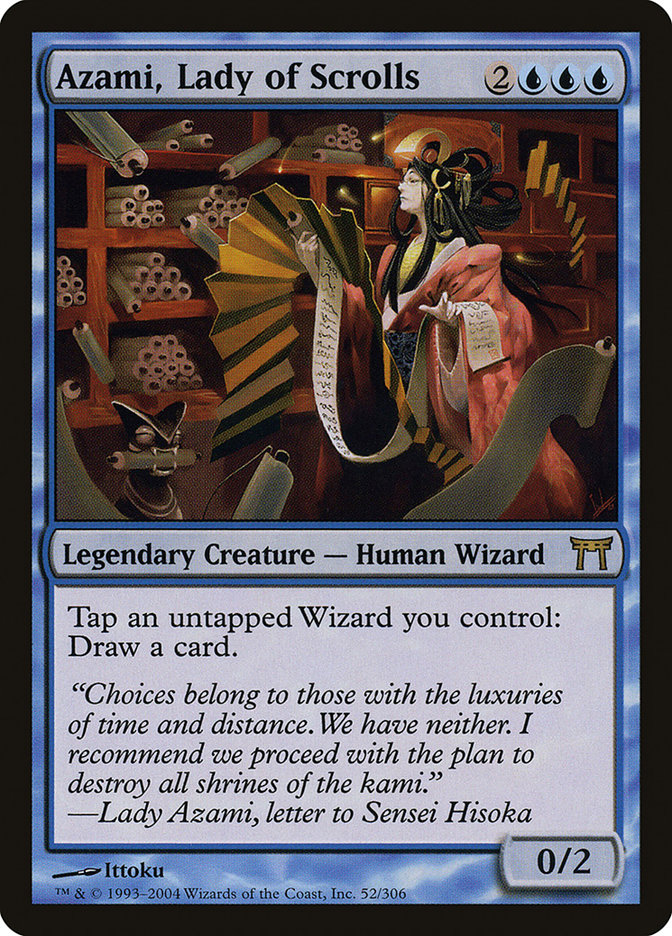
Another bright light standing out in Kamigawa block’s vast lineup of legendary creatures, the Lady of Scrolls has persisted thanks to a winning combination of memorable art, unique design and an open-ended ability that scales well for Commander play. In her case, Azami also got a little help at some point from a new lab assistant, which gave her a new role as the presumptive win condition for all sorts of self-milling combo decks up until the appearance of a certain Merfolk in 2020. But even if Thassa’s Oracle may have closed the book on Azami’s time in Constructed, her unique wording and popular creature type should be enough to prolong her Commander career indefinitely.
10. Kataki, War’s Wage

I could likely justify Kataki’s inclusion on this list from its prolonged sideboard use across Legacy, Vintage and Modern. It’s still among the most powerful hosers for artifact decks to this day, particularly in decks like Humans that prefer to use creature cards for utility and disruption. But when the history of Magic is written, Kataki’s most important role is as a testament to the desperation of post-Mirrodin Standard – a format where four copies of “one-sided Tabernacle” was still barely enough to give other decks a shot against the terror of Ravager Affinity. As an incarnation of the sobering cost of war, Kataki makes a perfect memorial for some of the most brutal gameplay Standard has ever seen.
9. Gifts Ungiven

Any card that has spawned multiple deck archetypes has earned a place in the Top 10 in my book! Gifts Storm, Gifts Reanimator, the Greater Gifts deck that Frank Karsten took to the grand finals of Worlds 2005 – and those are just the lists that reference Gifts Ungiven by name. Countless others have harnessed the power of this intriguing hand/graveyard tutor, which joined Doomsday and Brainstorm on the shortlist of “cards with whole subsets of Magic theory dedicated to them.” Were it not banned in Commander, Gifts would be even more iconic, but the frequency with which its name, effect and artwork have been riffed on since prove the extent of its influence.
8. Isamaru, Hound of Konda

Like Kodama of the North Tree, the context of Kamigawa Standard (or even Kamigawa Block Constructed!) is essential for understanding the reputation surrounding Magic’s long-time Goodest Boy. But while Isamaru was definitely a lynchpin for White Weenie in those days, his discount cost ensured a far longer period of Constructed relevance than the Kodama could ever hope for. During the early days of the Commander format, Isamaru was among the most popular choices to lead white decks, often donning Equipment and Auras to attempt lethal commander damage. And thanks to legendary creature support like Mox Amber, there is still room for this beautiful doggo in niche Modern aggro decks today!
7. Kokusho, the Evening Star (and the whole Spirit Dragon cycle)

While newer creatures have earned more limelight over the years, it’s impossible to overstate the significance of these legendary Dragons. These were the Shivan Dragons and Serra Angels of their day, and a minute of polling Magic fans online will still crop up a great many who claim one of these five as their “first favorite card.” But beyond the cool factor, their powerful death triggers set a new benchmark for expensive creatures in Constructed – guaranteed value for mana, regardless of whether they survived to attack. Future iterations on this theme would slowly take over modern creature design, to the point that Kokusho was eventually unbanned in Commander. When every creature printed since 2016 plays like that, what’s the point anymore?
6. Azusa, Lost but Seeking

We’re really getting into legendary territory here, both figuratively and, as it turns out, literally by card type. Azusa requires little introduction if you’re coming from Modern, Commander, or even recent Standard; she stands alone as one of the most explosive ramp engines ever printed. The fact that she can be easily tutored for, cheated out, reanimated and occasionally cloned only adds to her potential, despite her fragility in the face of removal. Azusa was clearly designed to test what kind of extra power the legend rule can keep in check, and while she’s rarely mentioned in ban discussions, Azusa is always seeking the borders of what can sensibly be called balanced.
5. One with Nothing

I have no idea how controversial (or not) this choice may be. But to me, One with Nothing is THE example of how an iconic card need not be powerful or even widely playable. We get plenty of new, powerful cards to look at with each new set, but we almost never see new cards like One with Nothing! This is the ultimate “Johnny Card,” practically daring brewers to search for its hidden power, and simultaneously, it’s the ultimate joke card – the one 90% of players will cite as “the worst card possible.” It’s important to have a card like that in the game, and while it was no doubt a terrible feeling to pull this from your first Saviors of Kamigawa booster pack, I’d like to think the cool factor of “a Zen Koan in Magic card form” justifies its existence.
4. Kiki-Jiki, Mirror Breaker

As one of the game’s most famous and effective combo finishers, Kiki-Jiki has proven his efficacy alongside a number of partners, from Deceiver Exarch and Pestermite as a backup Splinter Twin, to Restoration Angel in Jeskai combo-control, to various value Goblins in present-day Modern. He’s impossible to summarize in a paragraph like this because his usefulness and popularity transcends any single context, elevating him to the pantheon of Magic’s most enduring and visible staples. And yet, Kamigawa block has three more cards which are of even greater importance to the game…
3. Sensei’s Divining Top
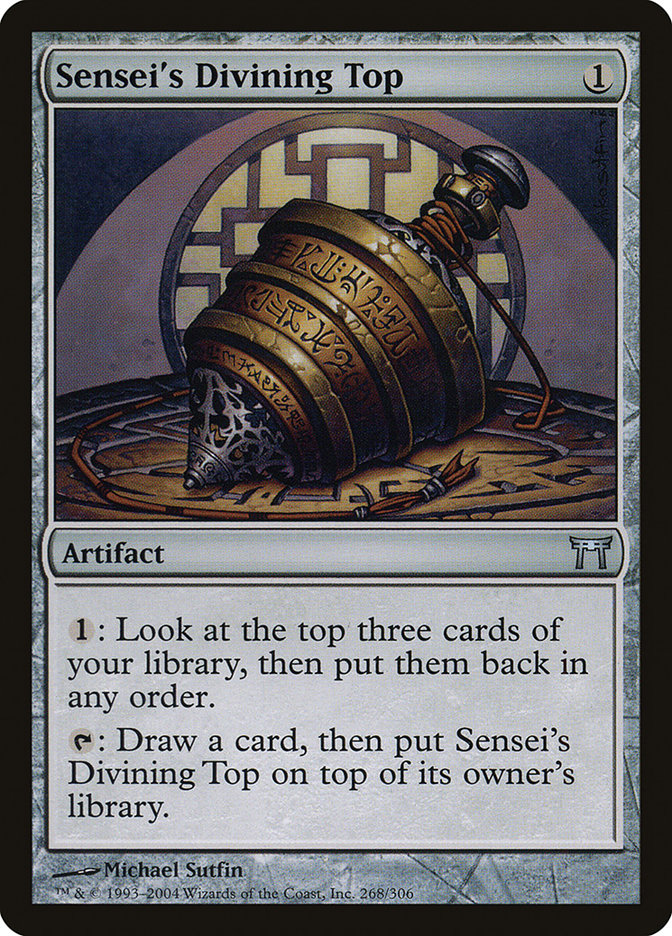
Sensei’s Divining Top is one of those subtly, completely broken cards beloved by Magic veterans – whenever they aren’t playing against it. Following Gifts Ungiven into the “strategic treatises evolved around me” club, and also the “banned in various formats” club, the Top truly earned those sanctions several times over. A hyper-efficient mana sink which improves almost any deck through sheer card selection and trickery, the artifact also has a less honorable function – forcing draws simply by how many match minutes one can spend pondering their Top. Banned firstly to spare judges that chicanery and later to spare Legacy players the torture of Counterbalance, Top remains an ultrastaple in Commander and still finds yet new ways to be absurdly busted every year or two.
2. Sakura-Tribe Elder
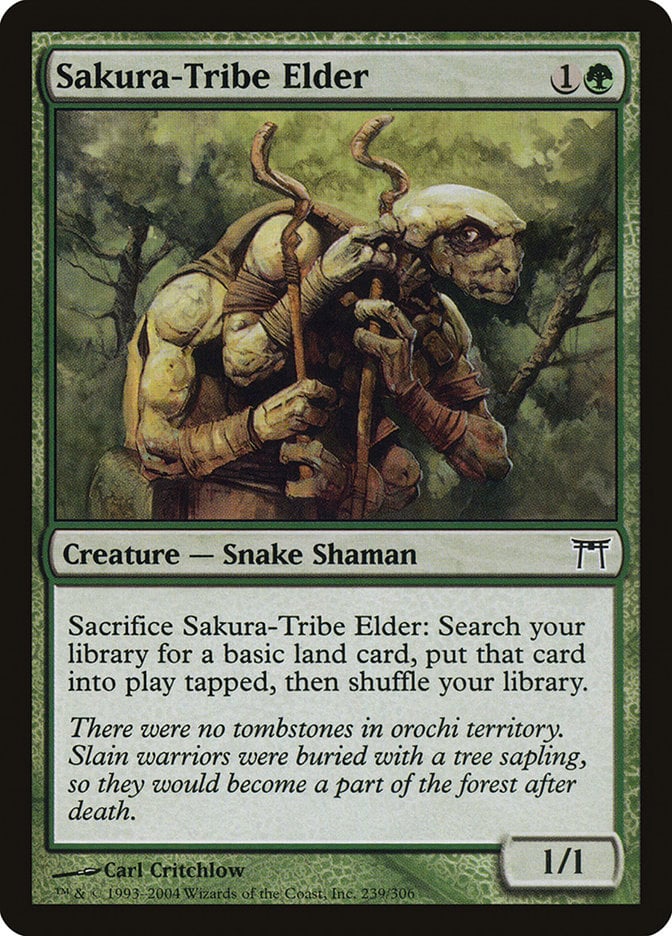
“Alright, Magic: The Gathering class of 2004, get ready to welcome our new transfer student! This here is Steve, and he’s going to be joining you every day for… well, probably as long as this game’s around!”
I feel comfortable opening with a joke because almost every Magic player already knows this guy. And if you don’t – no worries! – I’m sure you’ll learn to get along with STE(ve) quite soon. Birds of Paradise and Llanowar Elves may have the original rep as iconic green creatures, but modern design favors reprints of Sakura-Tribe Elder over one-mana dorks. I would even wager that, by this point, Steve may have edged those two out as the game’s most widely-recognized mana creature. Throw in all the neat little timing tricks that come from instant speed sac-shuffle-ramp (and with simply being a creature; see Azusa’s section), and you have one of the absolute foundational building blocks of modern-day Magic gameplay!
1. Umezawa’s Jitte

Yeah, you knew it was coming. Very likely the most powerful Booster Draft bomb of all time (and no slouch in Constructed), Umezawa’s Jitte has been leaving its mark on Magic players since the first one was pulled from a mono-black Rats Standard precon in 2005. (Yep, it was a precon rare!) Since that day, it has made Hand of Cruelty into a tournament threat, been banned from Modern, helped justify the existence of creature decks in Legacy, and proven to be unbeatable past the second charge counter.
It still might not be the absolute best Equipment card in Magic, but unlike the degenerate Skullclamp, Jitte has no famous anecdotes passing it off as a regrettable accident or design oversight. Unlike the “Sword of X and Y” cycle, it successfully promotes use of the combat step without discouraging interaction. And unlike Batterskull or Kaldra Compleat, Jitte manages to fulfill the intended role of Equipment as a buff to aggro instead of superseding creature cards altogether. Its flexible potential for big plays and clever lines only further ensures its extended life across every format where it’s legal – a fitting legacy for Magic’s original stay on Kamigawa.
WHAT NEW ICONS WILL EMERGE FROM NEON DYNASTY
One of the most exciting elements of a “return set” is the prospect of revisiting and reimagining the iconic cards of the past. We already have confirmation from the initial rounds of spoilers that some cards from this list will be riffed on in Kamigawa: Neon Dynasty – there’s new Spirit Dragons with designs lovingly iterating on the originals, a new Boseiju and most likely other legendary lands, and who knows how many more!?
Each new Magic expansion has the potential to produce an instant classic, like Skyclave Apparition or Sedgemoor Witch, that finds an immediate niche across many formats. Kamigawa: Neon Dynasty has that same potential, so this list will likely need a lot of revision come February. But that’s the kind of paperwork I’m always happy to do! Until then, enjoy catching up on the history of Kamigawa past with WotC’s upcoming month of lore!

Tom’s fate was sealed in 7th grade when his friend lent him a pile of commons to play Magic. He quickly picked up Boros and Orzhov decks in Ravnica block and has remained a staunch white magician ever since. A fan of all Constructed formats, he enjoys studying the history of the tournament meta. He specializes in midrange decks, especially Death & Taxes and Martyr Proc. One day, he swears he will win an MCQ with Evershrike. Ask him how at @AWanderingBard, or watch him stream Magic at twitch.tv/TheWanderingBard.
